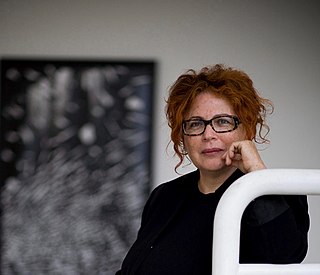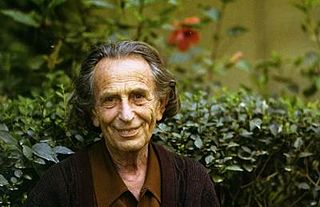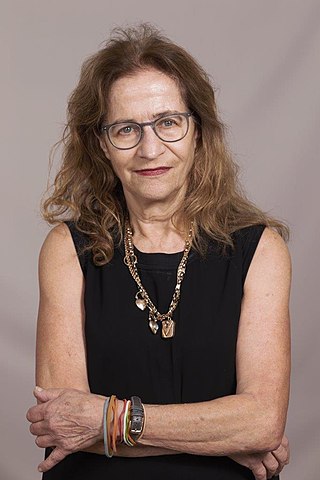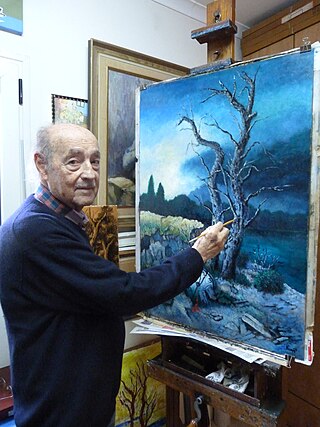
Gideon Gechtman was an Israeli artist and sculptor. His art is most noted for holding a dialogue with death, often in relation with his own biography.

Reuven Rubin was a Romanian-born Israeli painter and Israel's first ambassador to Romania.

Maya Cohen Levy, also known as Maya Cohen-Levy, is an Israeli painter and sculptor.

Pinchas Cohen Gan is a Moroccan painter and mixed-media artist. He was awarded the Sandberg Prize (1979), the Culture and Sport Ministry's prize for his life's work (2005), and the Israel Prize in Art (2008).
Eliahu Gat was an Israeli landscape painter.

Moshe Gershuni was an Israeli painter and sculptor. In his works, particularly in his paintings from the 1980s, he expressed a position different from the norm, commemorating the Holocaust in Israeli art. In addition, he created in his works a connection between bereavement and homoerotic sexuality, in the way he criticized society and Israeli Zionism-nationalism. He was awarded the Israel Prize for Painting for his work in 2003, but in the end it was revoked and he was deprived of receiving the prize.

Joseph (Yossef) Zaritsky was one of the early promoters of modern art in the Land of Israel both during the period of the Yishuv and after the establishment of the State. Regarded as one of the most influential Israeli painters, Zaritsky is known for cofounding the "Ofakim Hadashim" group. In his works, he created a uniquely Israeli style of abstract art. For this work he was awarded the Israel Prize for painting in 1959.

Zahara Rubin is an Israeli sculptor, painter and artist.

Yehezkel Streichman was an Israeli painter. He is considered a pioneer of Israeli modernist painting. Among the awards that he won were the Dizengoff Prize and the Israel Prize.

Michal Na'aman, is an Israeli painter. From the point of view of values, her work is characterized as conceptual art and deals with such subjects as the limitations of language and sight, the possibilities for expression, and gender issues. Using the techniques of collage, Na'aman has created works that examine the visual way of thinking as opposed to the verbal way of thinking. In 2014 she was awarded the Israel Prize for Plastic Arts for her work.

Arie Aroch was an Israeli painter and diplomat born in Kharkiv, now Ukraine and then part of the Russian Empire. Aroch's work was a mixture of Pop Art and abstract art, along with elements from his biography. In addition, many scholars of Israeli art history have pointed out Aroch's pioneering use of Jewish themes in his works. His painting style included unstructured scribbling and drawing, and it influenced a broad range of artists, including Raffi Lavie, Aviva Uri, etc. Sarah Breitberg Semel, in her article, Agrippa versus Nimrod (1988), suggested Aroch as a model for the new Israeli concept of design in art, and suggested his painting, Agrippas Street was the representative of Jewish identity. In 1971, Aroch was awarded the Israel Prize in Painting for his work.

Visual arts in Israel or Israeli art refers to visual art or plastic art created by Israeli artists or Jewish painters in the Yishuv. Visual art in Israel encompasses a wide spectrum of techniques, styles and themes reflecting a dialogue with Jewish art throughout the ages and attempts to formulate a national identity.

Uri Lifschitz was an Israeli painter.
David Leviathan is an Israeli painter, sculptor, and poet.

Zeev Kun was an Israeli painter of Hungarian origin. He is the father of the artist Shay Kun.

Michael Sgan-Cohen was an Israeli artist, art historian, curator and critic. His oeuvre touches different realms of the Israeli experience and the Hebrew language, displaying a strong connection to the Jewish Scriptures. His works were nurtured by his extensive knowledge of Art history, philosophy, Biblical Texts, Jewish thought and Mysticism, which in turn illuminated all these pursuits. His engagement with Judaism and the Bible as a secular scholar and his vast knowledge of modern and contemporary art contributed to the development of a distinctive approach which combined Jewish and Israeli symbols and images to create a multilayered and contemporary artistic language.

Ruth Schloss was an Israeli painter and illustrator. Major themes in her work were Arabs, transition camps, children and women at eye-level. She expressed an egalitarian, socialist view via realism in her painting and drawing.

Pinchas Abramovich was an Israeli painter during the period of the Yishuv and the following days of the state of Israel. He was one of the founders of the Ofakim Hadashim art group.

Hadar Gad is an Israeli artist.
Aharon Avni (Kaminkovitz) was an Israeli painter, born in Russia, a member of the 'Massad' group, founder of the 'Avni Institute,' and one of the founders of the HaMidrasha For the arts.
















